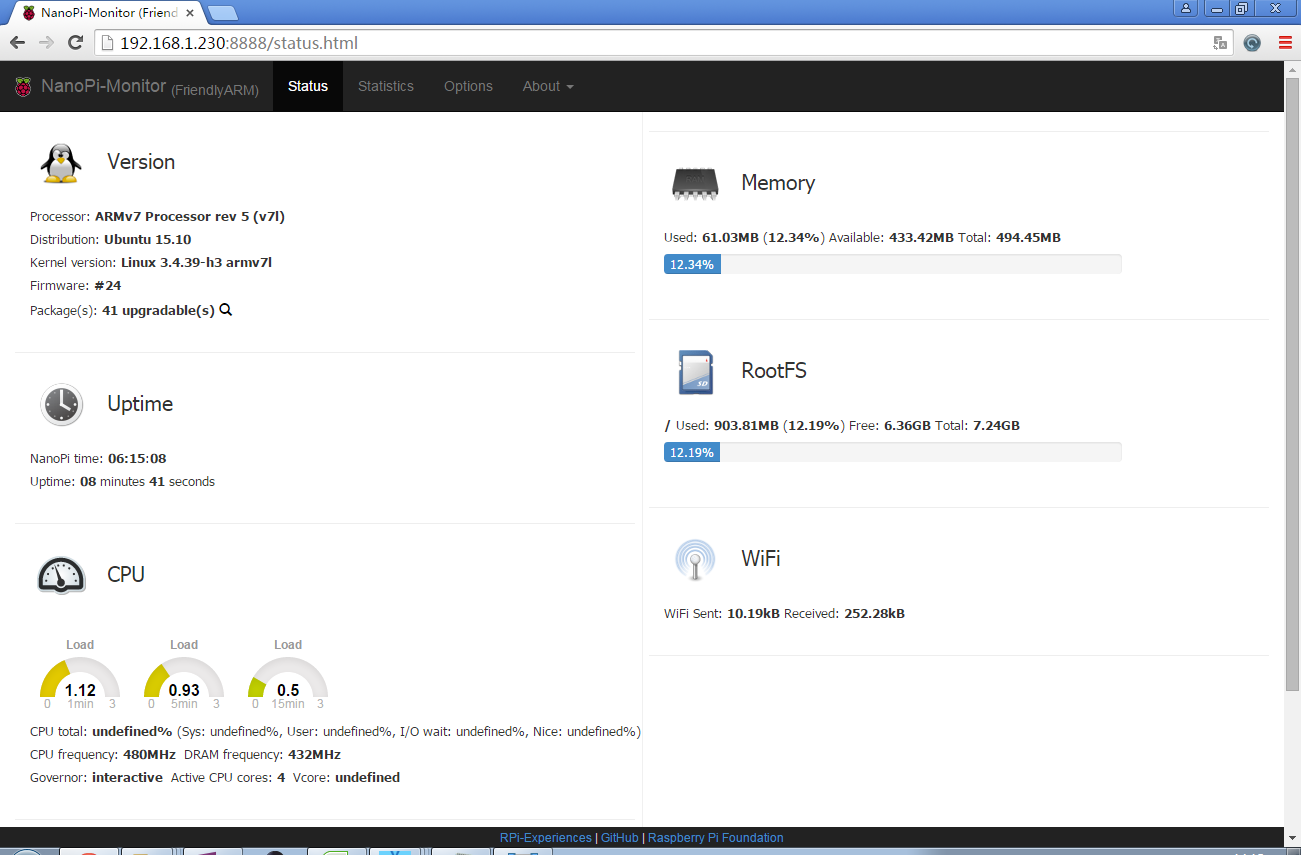Difference between revisions of "Template:FriendlyCoreAllwinnerH3"
(→测试看门狗) |
(→测试红外接收) |
||
| Line 56: | Line 56: | ||
System will reboot in 10 seconds. | System will reboot in 10 seconds. | ||
| − | === | + | ===Test Infrared Receiver=== |
| − | + | Note: this only applies to boards(such as NanoPi M1, NanoPi M1 Plus and etc) that have an infrared receiver. If you want to test boards(such as NanoPi NEO, NanoPi NEO Air and etc) that don't have an infrared receiver but have infrared pins you need to connect an infrared module to pin GPIOL11.<br> | |
| − | + | By default the infrared function is disabled you can enable it by using the npi-config utility: | |
<syntaxhighlight lang="bash"> | <syntaxhighlight lang="bash"> | ||
$ npi-config | $ npi-config | ||
| Line 65: | Line 65: | ||
ir Enable/Disable ir[enabled] | ir Enable/Disable ir[enabled] | ||
</syntaxhighlight> | </syntaxhighlight> | ||
| − | + | Reboot your system and test its infrared function by running the following commands: | |
<syntaxhighlight lang="bash"> | <syntaxhighlight lang="bash"> | ||
$ apt-get install ir-keytable | $ apt-get install ir-keytable | ||
| − | $ echo "+rc-5 +nec +rc-6 +jvc +sony +rc-5-sz +sanyo +sharp +mce_kbd +xmp" > /sys/class/rc/rc0/protocols # | + | $ echo "+rc-5 +nec +rc-6 +jvc +sony +rc-5-sz +sanyo +sharp +mce_kbd +xmp" > /sys/class/rc/rc0/protocols # Enable infrared |
$ ir-keytable -t | $ ir-keytable -t | ||
Testing events. Please, press CTRL-C to abort. | Testing events. Please, press CTRL-C to abort. | ||
</syntaxhighlight> | </syntaxhighlight> | ||
| − | ir-keytable - | + | "ir-keytable -t" is used to check whether the receiver receives infrared signals. You can use a remote control to send infrared signals to the receiver. If it works you will see similar messages as follows: |
<syntaxhighlight lang="bash"> | <syntaxhighlight lang="bash"> | ||
1522404275.767215: event type EV_MSC(0x04): scancode = 0xe0e43 | 1522404275.767215: event type EV_MSC(0x04): scancode = 0xe0e43 | ||
Revision as of 08:23, 13 April 2018
Contents
1 Connect to USB Camera(FA-CAM202)
The FA-CAM202 is a 200M USB camera, 连接测试USB摄像头的方法请参考 <连接DVP摄像头模块(CAM500B)> 章节。
请自行修改start.sh, 确保使用正确的/dev/videoX节点, 下列命令可以用来确定FA-CAM202摄像头的video节点:
$ apt-get install v4l-utils $ v4l2-ctl -d /dev/video1 -D Driver Info (not using libv4l2): Driver name : uvcvideo Card type : HC 3358+2100: HC 3358+2100 Bus info : usb-1c1b000.usb-1 ...
2 Check CPU's Working Temperature with Commandline Utility
You can get CPU's working temperature by running the following command in a commandline utility:
$ cpu_freq CPU0 online=1 temp=26581 governor=ondemand cur_freq=480000 CPU1 online=1 temp=26581 governor=ondemand cur_freq=480000 CPU2 online=1 temp=26581 governor=ondemand cur_freq=480000 CPU3 online=1 temp=26581 governor=ondemand cur_freq=480000
This message means there are currently four CPUs working. All of their working temperature is 26.5 degree in Celsius and each one's clock is 480MHz.
3 Check System Information with Rpi-Monitor
Our OS contains the Rpi-Monitor utility with which users can check system information and status.
In our case our board's IP was 192.168.1.230 and we typed the following IP in a browser:
192.168.1.230:8888We were directed to the following page:

Users can easily check these system information and status.
4 Test Watchdog
You can test watchdog by running the following commands:
$ cd /root/demo/watchdog/ $ gcc watchdog_demo.c -o watchdog_demo $ ./watchdog_demo /dev/watchdog0 10 Set timeout: 10 seconds Get timeout: 10 seconds System will reboot in 10 second
System will reboot in 10 seconds.
5 Test Infrared Receiver
Note: this only applies to boards(such as NanoPi M1, NanoPi M1 Plus and etc) that have an infrared receiver. If you want to test boards(such as NanoPi NEO, NanoPi NEO Air and etc) that don't have an infrared receiver but have infrared pins you need to connect an infrared module to pin GPIOL11.
By default the infrared function is disabled you can enable it by using the npi-config utility:
$ npi-config
6 Advanced Options Configure advanced settings
A8 IR Enable/Disable IR
ir Enable/Disable ir[enabled]Reboot your system and test its infrared function by running the following commands:
$ apt-get install ir-keytable $ echo "+rc-5 +nec +rc-6 +jvc +sony +rc-5-sz +sanyo +sharp +mce_kbd +xmp" > /sys/class/rc/rc0/protocols # Enable infrared $ ir-keytable -t Testing events. Please, press CTRL-C to abort.
"ir-keytable -t" is used to check whether the receiver receives infrared signals. You can use a remote control to send infrared signals to the receiver. If it works you will see similar messages as follows:
1522404275.767215: event type EV_MSC(0x04): scancode = 0xe0e43 1522404275.767215: event type EV_SYN(0x00). 1522404278.911267: event type EV_MSC(0x04): scancode = 0xe0e42 1522404278.911267: event type EV_SYN(0x00).
6 Access GPIO Pins/Wirings with WiringNP
The wiringPi library was initially developed by Gordon Henderson in C. It contains libraries to access GPIO, I2C, SPI, UART, PWM and etc. The wiringPi library contains various libraries, header files and a commandline utility:gpio. The gpio utility can be used to read and write GPIO pins.
FriendlyElec integrated this utility in FriendlyCore system allowing users to easily access GPIO pins. For more details refer to WiringNP WiringNP
7 Run Qt Demo
Run the following command
$ sudo /opt/QtE-Demo/run.sh
Here is what you expect to observe. This is an open source Qt Demo:
